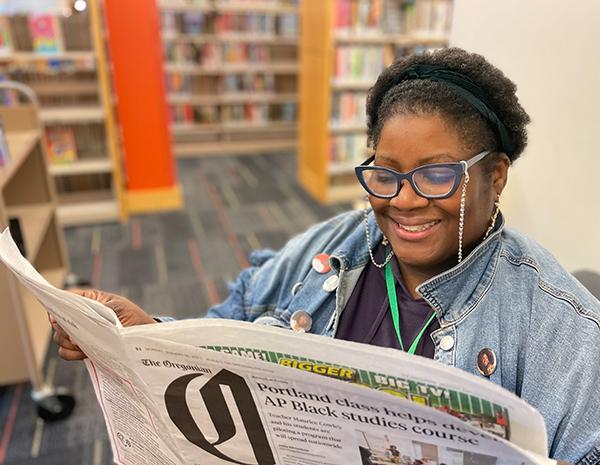Black-owned newspapers date back to before the Civil War. Even after Black people began publishing newspapers, there were areas of the country where people still communicated in secret to avoid violence and suspicion. In much of the country, Black people, especially enslaved Black people, lived under governments that made it illegal for them to read or write. When Black people wrote, read and published their own newspapers, it was an act of vital resistance against oppression.
"Newspapers are essentially the time capsules of society, and from them, you can learn a great deal about the everyday lives of Black people who lived in the past. I've learned so much about the history of Black people in Oregon that was never taught in school," says Lanel Jackson, Black Cultural Library Advocate (BCLA) library assistant. Lanel's research provides the foundation for this article.

To find information from local Black-owned newspapers:
- Portland State University's Library Special Collections' Historic Black Newspapers of Portland includes digital and paper versions and can be accessed without a library card or student ID.
- University of Oregon's library includes The New Age, the first African American newspaper published in Oregon.
- The Library of Congress has a chronicle of over 200 African American newspapers from many states and time periods.
By the turn of the century, there were over 500 Black-owned publications nationwide. The first publicly recorded Black-owned newspaper in the United States was Freedom’s Journal, established in 1827 in New York. It distributed 103 issues before shutting down in 1829. Freedom’s Journal was a source of information for thousands of Americans seeking information about health, entertainment, education and more.
Black-owned newspapers covered the fight for civil rights, marriage, death, divorce, birth announcements, residents moving to new locations, visitors, and achievements of community members. They sometimes included people's home addresses and pictures of the owner.
In 1896, Adolphus Griffin established the first Black-owned newspaper in Oregon, The New Age. Also known as the Portland New Age, the weekly newspaper published local and national information until its end in 1907.
In 1903, E.D. Cannady published the first issue of The Advocate, which covered segregation, employment and more. When E.D. Cannady married Beatrice Cannady, she became the lead publisher and editor of The Advocate until its closure in 1938.
Stories about incidents and events often evolved over days, weeks or even years. As a result, additional research may be needed to uncover a story's facts. Read historical Black-owned newspapers from different areas to discover connections made between people in Portland and other cities along the West coast.
You can also find more newspapers through the library’s EBSCOHost and Pro-Quest databases with your library card number. With Pro-Quests Ethnic NewsWatch, read current and historical coverage of various communities of language and culture.